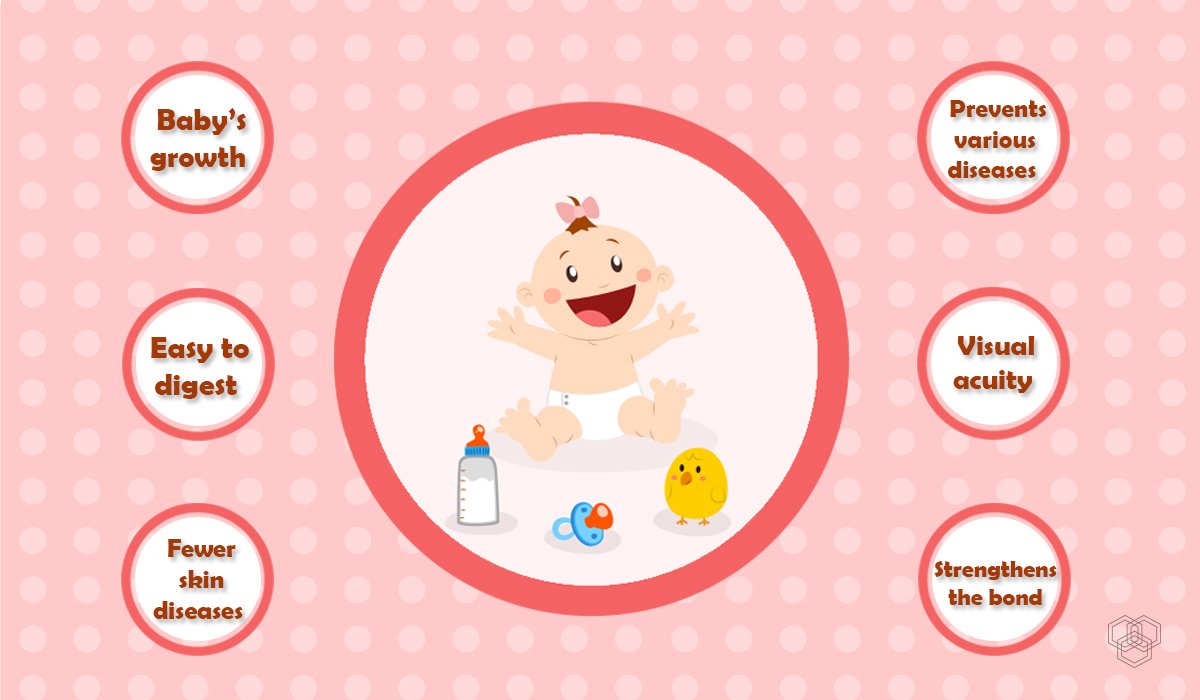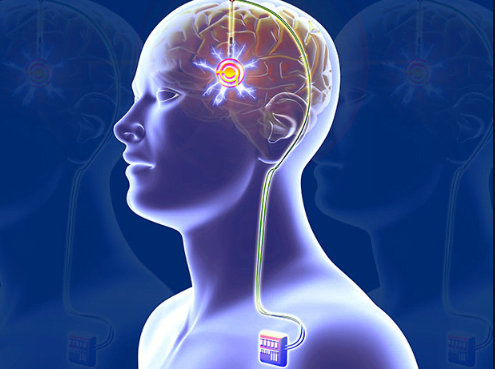Breast milk is complete nutrition for the baby for the first six months. It offers numerous health benefits to both the baby and the mother. Apart from nutritional benefits, it also builds the emotional bond between the mother and child.
Benefits for the mother

Breastfeeding has a multitude of benefits for the mother as well. Some of them are as follows:
Lowers the risk of breast cancer and ovarian cancer
Studies have shown that women who breastfeed have a lower risk of breast cancer and ovarian cancer. Breastfeeding provides long-term protection against different types of cancers.
Prevents depression
After childbirth, women might get depressed; the condition is known as postpartum depression. Studies have shown that women who breastfeed are less likely to get postpartum depression. These women have high amounts of oxytocin in their systems. It facilitates a strong bond of affection between the mother and child. Further, it makes women feel relaxed.
Helps in reducing pregnancy weight
Breastfeeding burns 300 to 500 extra calories a day. This is the easiest way of losing weight after pregnancy.
Lowers the risk of heart diseases and high blood pressure
Women who breastfeed their babies are less likely to have heart disease and high blood pressure. Studies have shown that breastfeeding protects a woman against metabolic syndrome. A metabolic syndrome is basically a group of conditions that raise the risk of heart diseases. Breastfeeding also reduces the risk of several other diseases.
Lowers the risk of diabetes
Women who breastfeed their babies for three months have a 30% less chance of having Type 1 diabetes and a 40% less chance of having Type 2 diabetes.
Prevents menstruation
By continuous and regular breastfeeding, ovulation and menstruation are paused in a woman. This is a natural way to have a gap between the pregnancy by pausing the menstruation cycle. Women may also use it as birth control for a few months after the delivery of the baby. This, however, is not a completely effective way of birth control.
It saves time and money.
Breastfeeding is a natural way of feeding a child and therefore is convenient. For breastfeeding, you don’t need to worry about buying formulas and mixture at all. It also saves you from buying milk bottles and sterilizing them again and again.
Benefits for the baby

From the provision of nutrition to strengthen the baby’s immune system, breastfeeding has various benefits.
Some of them include:
Prevents various diseases
Breast milk contains antibodies that protect the baby from illnesses. Antibodies help babies fight against viruses and bacteria. Breast milk also prevents various diseases like hypertension, obesity, diarrhea, ear infection, and pneumonia. Further, it prevents respiratory problems like asthma and other related allergies.
Breastfed babies also have fewer obesity rates than formula-fed babies. It basically encourages and develops healthy weight gain and prevents childhood obesity.
Studies have shown that babies who breastfeed have 15 to 20 % obesity rates than babies who are formula mixture fed. It also reduces the risk of obesity for the future by 4%.
Visual acuity
The visual acuity in the babies fed breast milk is higher than those who are not. So, it improves the eyesight of the baby.
Strengthens the bond with their mother
Breastfeeding strengthens the bond of the child with their mother. It satisfies the emotional needs of the baby.
For the baby’s growth
Breast milk has the right amount of sugar, fat, water, proteins, and minerals needed for the baby’s growth. Breast milk contains everything that your baby needs for the first six months. It is a complete food for the newborn baby. It is also the basis for healthy development.
The first milk that is produced after giving birth to the baby is a thick yellowish fluid. It is called colostrum. Colostrum is higher in proteins, contains less sugar, and also contains beneficial compounds for the baby. Colostrum is ideal milk for the baby’s growth and development.
Easy to digest
Breast milk is easy to digest. It is more digestible, and it is easily absorbed in the baby’s digestive system. Mothers who breastfeed their babies are less likely to have gas and constipation problems. Breast milk satisfies the hunger of the baby. It also develops the healthy eating patterns of a baby.
Higher IQ
Breast milk contains cholesterol and another type of fat. It supports the growth of the nerve tissue. Breastfeeding also affects the baby’s brain development. It also lowers the risk of learning problems in the baby.
Studies have shown that the babies who are breastfeeding have higher IQs than the ones who aren’t. The fatty acids in breast milk are for brain boosters. It makes a child smarter.
Strengthens the endocrine system
Breastfeeding reduces and lowers the risk of getting diabetes.
Strengthens the immune system
Breast milk-fed babies respond better to vaccination. It helps to mature the immune system. Breast milk provides nutrition that strengthens the immune system of a baby. It also enhances and boosts the immune system of the baby. It also reduces the risk of childhood cancer.
Fewer skin diseases
The chances of skin diseases in babies are also reduced because of breast milk.
Reduced risk of infections
Breastfed babies are less likely to have infections like polio, tetanus, diarrhea, gastrointestinal infections. There is also a reduced probability of Crohn’s disease and ulcerative colitis in adulthood in these babies.
Because of breastfeeding, there is a 64% less risk of gut infection in the babies. Babies who are breastfed for six months may have a 63% less risk of getting ear infections and serious colds.
Heart rate
Breastfeeding babies have lower cholesterol than adults. Heart rate is in control in breastfed children.
Less risk of respiratory and throat infections
Breastfed babies have fewer respiratory infections and rotaviruses. They have less wheezing, influenza, and pneumonia. Studies have shown that breastfed babies for four months may have a 72% lower risk of having respiratory infections.
Breastfed babies are less likely to require tonsillectomies. Babies who are breastfed for six months may have a 63% lower risk of having throat infections.
Inflammatory bowel diseases
Breastfed babies have a 30% lower risk of inflammatory bowel diseases. Breastfed babies are either less likely to have urinary infections and constipation problems.
Risk factors of artificial feeding
- Vitamin A deficiency
- Overweight
- Less intelligence
- Higher risk of allergies
- Increased risk of chronic diseases
- Higher risk of breast cancer and ovarian cancer
- More responding to respiratory infection
- Women may become pregnant before long or sooner
- Restrain with bonding
- More chance and risk of diarrhea
Devices that aid breastfeeding
Device to measure breast milk volume
A device has been designed to measure how much milk the breast is producing and how much of it does the baby drink. This device uses electromagnetic signals to measure milk volume in the breast before and after feeding the baby.

- Gives accurate results
- Small in size
- Portable
- When switched on, it produces audio cues
- Tests the breast milk volume
- Can be strapped on the mother for hands-free usage or even placed on the mother’s lap
- Environment-friendly
- Satisfied outcomes
- When not in use, the device can be put to sleep mode
- Effective and efficient
Nipple shields
Nipple shields are made of a thin silicone casing that is placed over the nipple. The main purpose of the nipple shield is to facilitate the baby to suck breast milk and make the baby stay sucking on the breast. However, nipple shields are not the treatment for sore nipples.

Some of the basic facts to understand about nipple shield are as follows:
- A nipple shield is especially for the premature babies
- There’s a probability of nipple shields producing less milk
- A nipple shield is usually needed for a short period
- It is essential to use nipple shields under the control of the lactation consultant.
- Remember, nipple shields are a much better option than not breastfeeding at all.
Breast Pump
The breast pump is a device used to extract and collect milk from a woman’s breast by suction.

A few important considerations include:
- Select the right pump
- Make sure that breast pump borders exactly fit the breast. It should neither be too large or too small.
- Place the breast pump borders on the front and center of your nipple
- Make sure that you are holding it in front of your nipple
- Begin it with the smooth suction
- Do not over-do pumping
- Pump for every gone and missed feed
- Pump till milk comes out and is adequate for the baby
- For enhancing and boosting the supply of milk, keep on pumping
Conclusion
Given its advantages, Breastfeeding should be encouraged. It should be offered as the sole diet to the baby up to 6 months and can later be given until any desirable age (preferably up to 2 years).
Inspired by: HealthLine







Share Your Thoughts